
IT’S HARD, DURABLE, AND CRINKLY. WHEN IT GETS WET, IT CAN BECOME A BIG, HOT MESS. BUT THESE ARTISTS LOVE IT AND KNOW HOW TO EXPLOIT ITS EXPRESSIVE POWER.
by Edward M. Gómez
One person’s trash is another’s precious raw material for making art.
That’s a theme that has long run through the creations of many a self-taught artist working on the margins of mainstream culture and society; often, it seems, such outsider artists do not have the financial resources that allow them to purchase top-quality paints, canvas, glues, drawing paper, or other art-making supplies. The art of making do is a big, multifaceted one in itself.
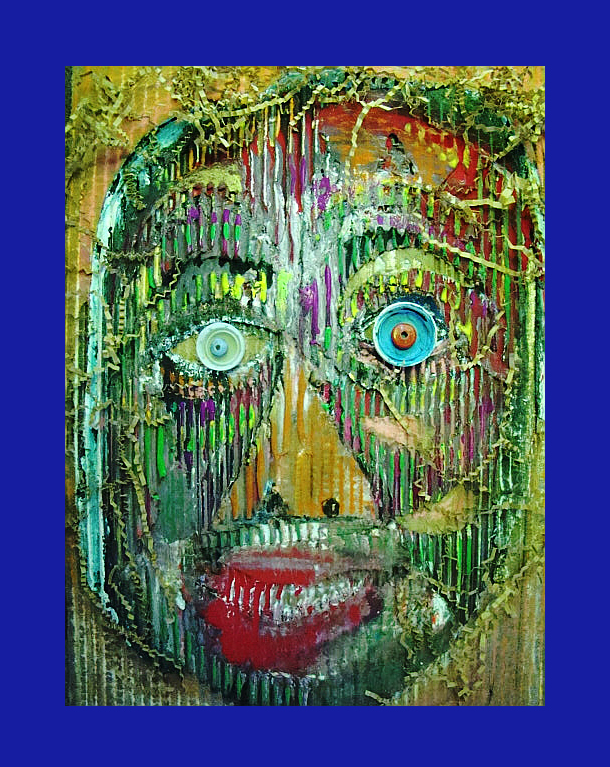
This month, we’re especially interested in artists who have a thing about cardboard — everything from the kind of thick card stock that is used for printing greeting cards or advertising materials to the billions of corrugated-cardboard boxes that are manufactured every year, all over the world, and often thrown away after being used only once as containers for packed and delivered goods of all kinds.
Pablo Picasso, modern art’s indefatigable experimenter, made paintings on the exposed-corrugation surfaces of long cardboard sheets; see, for example, his 1952 picture of a devil, in black and white gouache, in the collection of the Art Institute of Chicago, whose simple palette of two colors picks up a third from the brown of the thick paper.
An even more unadulterated use of cardboard to make art can be found in a group of wall-mounted sculptural works the American artist Robert Rauschenberg, a master combiner of just about everything, created using cast-off corrugated-cardboard boxes in the period from 1971 to 1972. At the time, the artist was working at his studio on Captiva Island off Florida’s west coast.
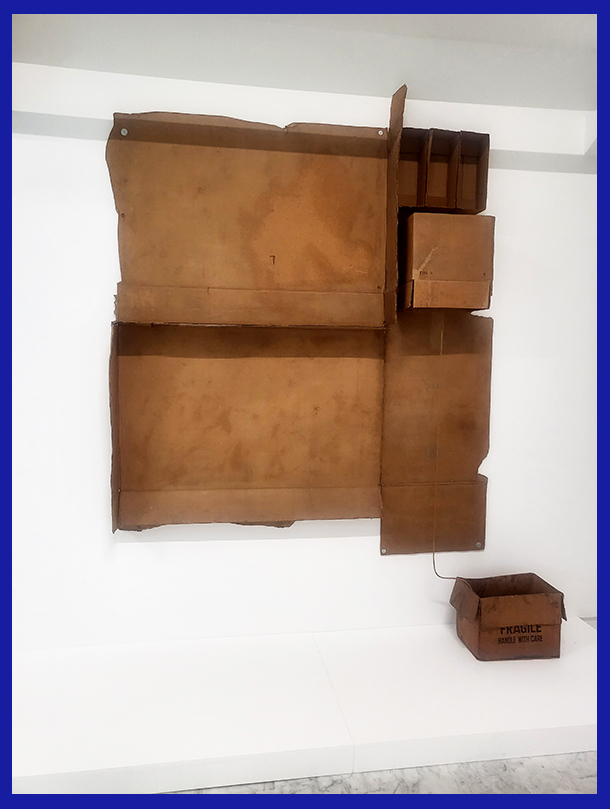
Recently, Martha Wilson, a New York-based artist and the founding director of Franklin Furnace Archive, was in Marseille, the great port city in the south of France, for the opening of her exhibition Martha Wilson: Invisible — Works on Aging (1972-2022) at FRAC Sud/Cité de l’art contemporain.
While exploring the permanent collection at another museum, Marseille’s Musée d’Art Contemporain, Wilson encountered one of Rauschenberg’s cardboard-assemblage works from that early-1970s period and, knowing that we were interested in such concoctions, brought it to our attention.
The piece was “½ Gals, AAPCO” (photo, above), a definitive example of Rauschenberg’s signature artistic gestures, which were rooted in Marcel Duchamp’s appropriation and repurposing of found objects. Through his art-making actions, Rauschenberg transformed the value of his materials and, to use a favorite postmodernist buzzword, recontextualized them, imbuing them with all-new meanings. His purposefully arranged, cast-off cardboard boxes became examples of one of the abiding hallmarks of modernist aesthetics — the recognition and celebration of the expressive power of pure form (and color and texture, too).
Many years after he produced those cardboard works, Rauschenberg told an interviewer from the French newspaper Libération, “The objects I use are usually imprisoned in their ordinary banality. […] In New York, it’s impossible to walk through the streets without seeing a tire, a bottle, a box. All I do is take them and give them back to their own world.”

A documentary program about the manufacturing and use of corrugated cardboard in Japan, which was produced by NHK World, the Japanese broadcasting service, and first made available late last year, points out that this wonder product was first made in Britain in the mid-1800s. Its purpose: to serve as a lining for gentlemen’s top hats, absorbing perspiration and improving ventilation in their tall, cylindrical chambers. Subsequently, in the United States, corrugated cardboard was used for packing lamps and other fragile goods.
In Japan, the production of corrugated cardboard began in the early 20th century, and, today, Japanese designers and manufacturers have come up with just about every packaging solution and practical application of the sturdy material imaginable, from customized boxes for all sorts of home-delivery goods to easy-to-set-up beds.
Corrugated cardboard — it’s hard, it’s durable, it’s crinkly, and, when it gets wet, it can become a big, hot mess. But we love it, and in this two-part expanded portfolio (see part two on the BIG PAGE), we’re excited to introduce the experiments and creations of a diverse group of artists who have brought wit and wizardry to their use of cast-off cardboard to make art.
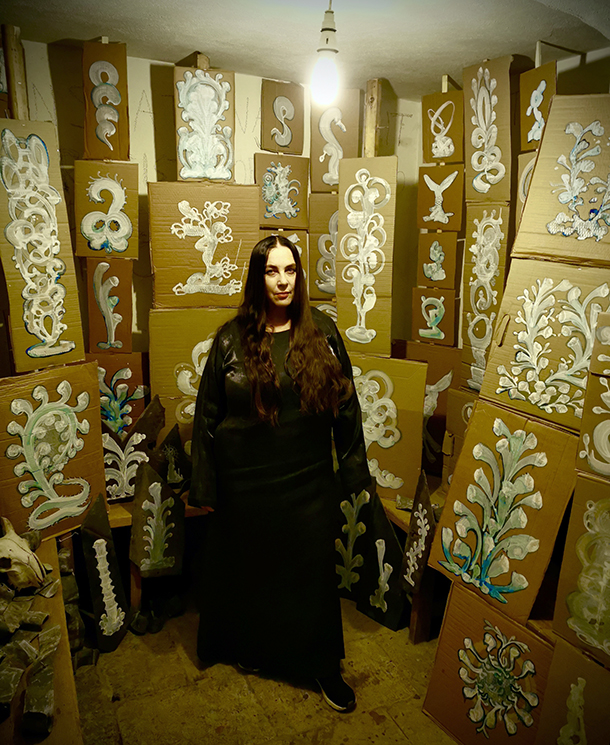
Several artists have let us know that corrugated cardboard is one of their painting or drawing surfaces of choice. In 2019, Cathy Ward (Instagram: @wardsisterward), brutjournal’s London-based artist-correspondent, took part in a residency program at — or, more precisely, in — the Curfew Tower, where she spent a few weeks occupying a living-working space in a 19th-century, 40-foot-tall, four-story guard tower in Cushendall, a small, coastal town in the far northeast of Northern Ireland. There, she made a batch of paintings with gesso, paint, and her own hair on found sheets of corrugated cardboard. Collectively, they became her “Rite of Spring” series.
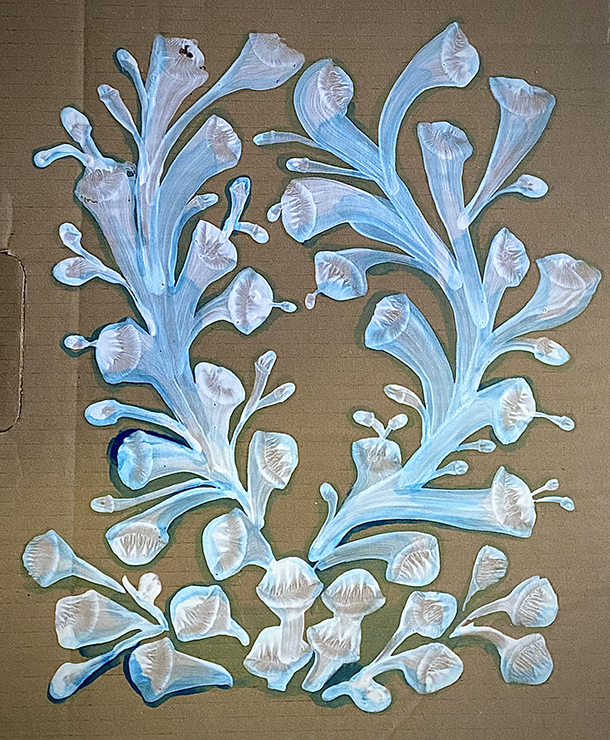
About that residency period, Ward recalled, “I went around the town night after night collecting as much cardboard as I could from a variety of sources — from outside private houses, greengrocers’ and butchers’ shops, drugstores, and food stores. My idea was to introduce a ‘community source’ into the historic tower, that is, some locally sourced material for my work that would bring the spirit of the village and its inhabitants into the tower with me.”
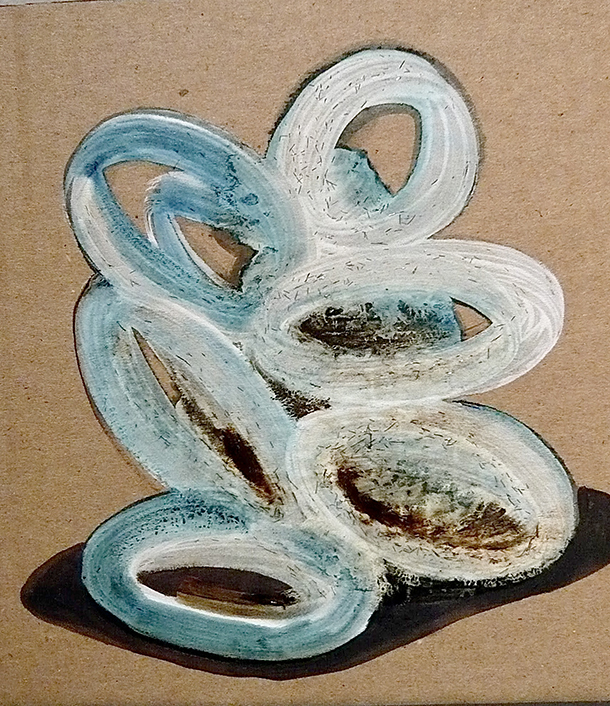
Ward added, “I wanted something that had been used, that had had a life, a purpose, and a human use. Something that could continue having a use.” Ward tried to put into words another, more ephemeral aspect of the paintings she produced during her residency period in the tower.
She told us, “The meaning behind all of these works has to do with regeneration. In them, I tried to create a kind of alchemy using my DNA — strands of my own hair — in that historic building with its tower, where I wanted to reactivate the spirits of lost, once living forms that had been associated with it in the past. I was thinking about reactivating the spirits of organic matter. For me, these paintings are like objects that were made from some kind of fertile effluent that became frozen and preserved in ice. They’re presented like placards declaring a political stance — that all living things have the right to see another spring.”
Dasha Shishkin (Instagram: @dashashishkin) divides her time between Brooklyn and East Branch, a rural town in south-central New York State. A graduate of Parsons School of Design and of Columbia University, where she studied in the graduate-level fine-arts program, Shishkin describes her artistic tastes as “eclectic” and adds, “I think this is reflected in my work.”
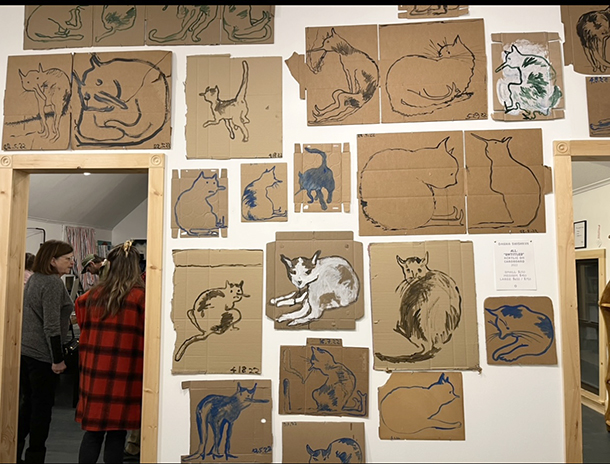
About her penchant for cardboard, which she has been using as the support surface for her paintings of cats, she told us, “I prefer to work with distressed materials, repurposing them. I have two dogs and a cat, and I love pizza, so I have a lot of cardboard that comes my way as packaging. That’s why my paintings are roughly identical in size, because they’re all made on the same type of boxes I receive twice a month.”
Shishkin explained, “Since I began to receive many dog-food parcels — one of my dogs was diagnosed with diabetes and requires special food — I felt that by drawing on the boxes, I’m extending their use. I find that I make very specific kinds of marks when I work on this cardboard.”
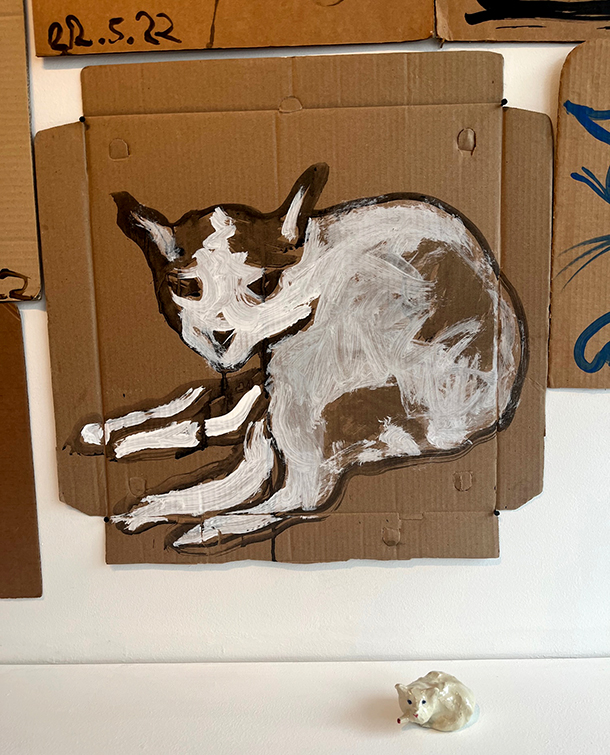
We asked the artist if there are any particular characteristics of cardboard that serve her art-making purposes. She said, “I use watered-down acrylic paint, often blue, without any preparation of the cardboard surface. I especially like it when there are blemishes on the cardboard — usually on pizza boxes. I like this surface for its level of absorbency and for the springy feel of the support [it provides]. I especially like the odd shapes [of the cardboard] I purposefully do not alter but that I accept as they come. Since it is repurposed cardboard, often it has odd marks, and I seek them out.”
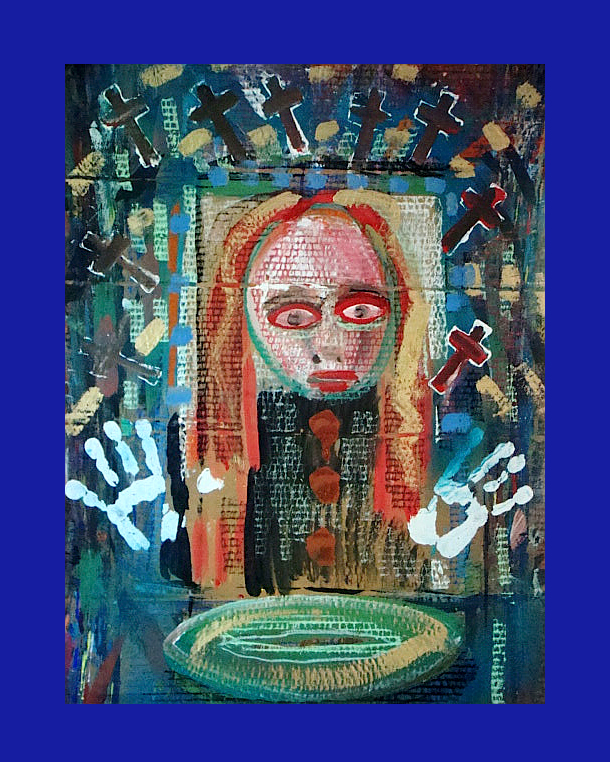
From northern Minnesota, where she lives and works near a forest, with easy access to the outdoors, brutjournal contributing artist Alma Realm (Instagram: @almarealm) tells us, in her typically succinct manner, “I like the structure of corrugated cardboard and the sound it makes when I’m working against its ridges.”
Realm brings the same bold palettes and broad, decisive brushstrokes to her compositions on cardboard that she does to her paintings on paper. In fact, the combination of sturdy cardboard and the artist’s vigorous painting style seems to come together very naturally.
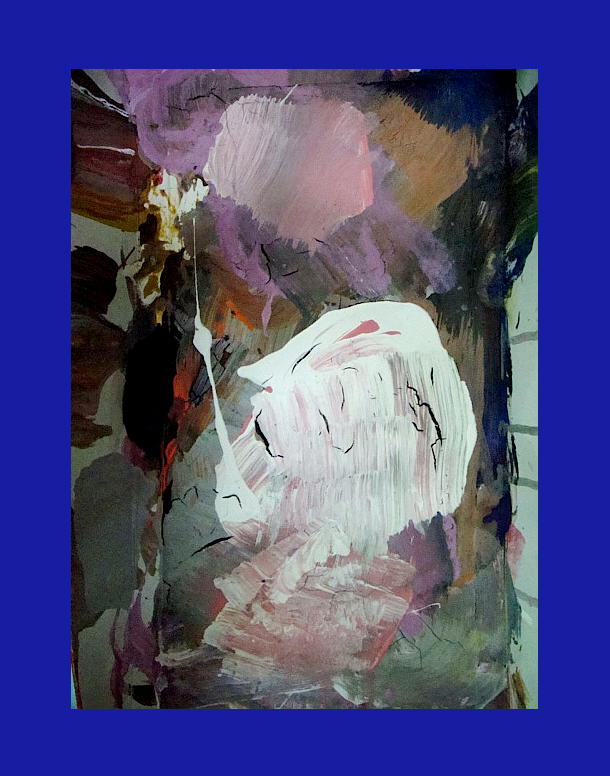
The artist Diane Rosen (Instagram: @dianerosenstudio) lives and works in a small town in the Hudson Valley region, north of New York City. Like several other artists with whom we’ve been in touch, Rosen noted that, to make her paintings (with acrylic paint and soft pastels), she uses cardboard from the boxes in which online purchases are delivered to her home.
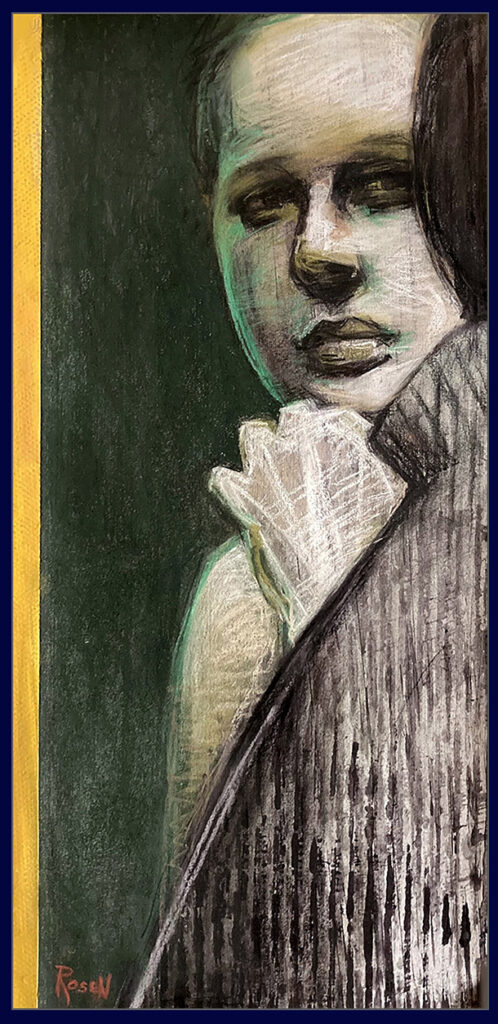
Rosen explained, “I use [corrugated] cardboard by tearing off its smooth paper surface and exposing its inner ridges and grooves, which serve as a [kind of] found printing block. Then I ink and press the torn cardboard onto a pastel/acrylic image to print random marks and lines.” In this way, the artist said, she enjoys “engaging the tension between familiar and strange, text and subtext, control and accident.” She added, “Mixing media in unexpected ways enables me to weave unpredictability into a deliberate process, so, although my figures are grounded in realism, they and their contexts are rendered ambiguous.”
In Rosen’s hands, cardboard serves as much as a tool as it does as a material of her art-making process.
About her background as an artist, Rosen said, “I’m ‘trained’ but via a self-directed path, with no academic art degrees. I studied at the Art Students League in New York and independently at the École des Beaux-Arts in Paris on a French government painting fellowship. My year in Paris was decisively formative.”

About the art she encountered in museums in France, Rosen recalled, “In particular, seeing Edgar Degas’ innovative blending of classical realism and radical composition techniques, which were inspired by Japanese ukiyo-e woodblock prints, strongly influenced my direction. Moving away from traditional realism, I began focusing on flattened planes or compressed space rather than linear perspective; asymmetrical design; and cropped figures in unexpected relationships with line, shape and materials. Cardboard affords me an additional tool for exploring the extraordinary in the everyday.”
[Discover the work of more artists who use cardboard to create their work. See part two of this report on the BIG PAGE.]


